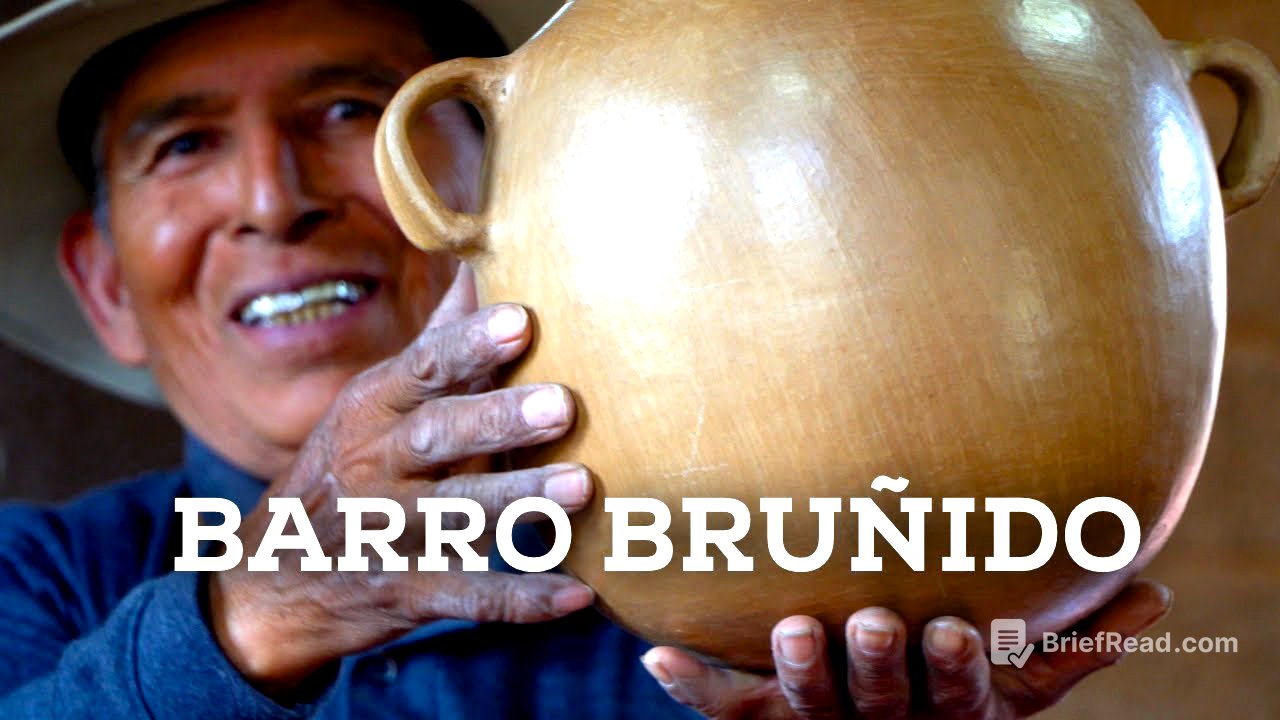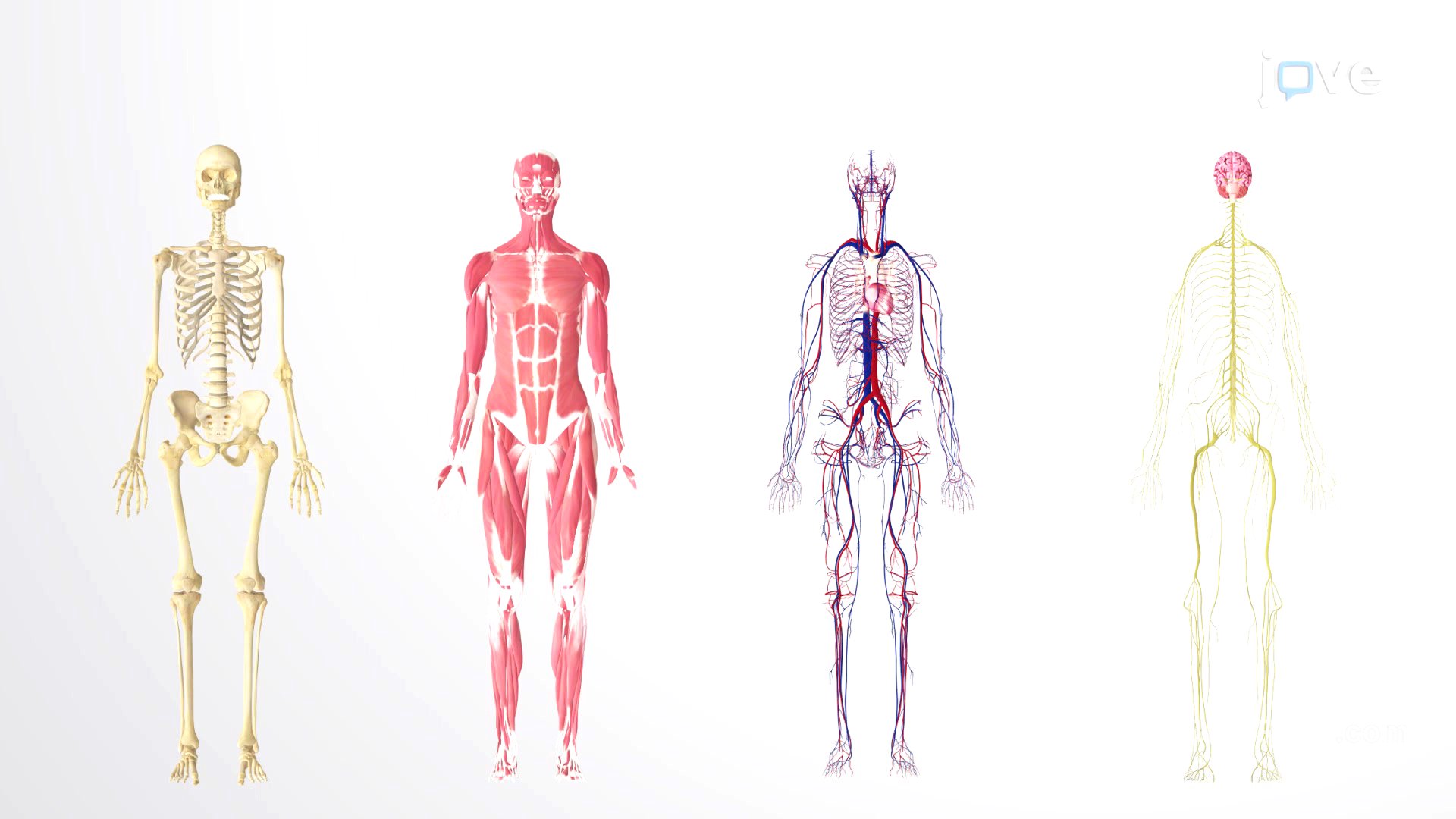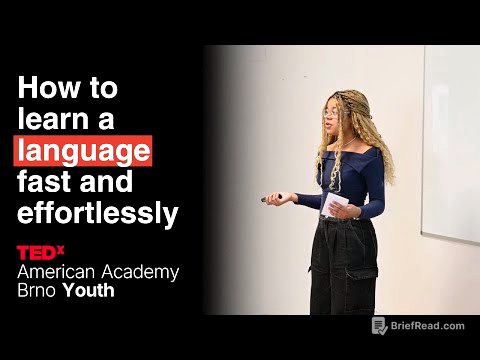TLDR;
This video explores the traditional pottery-making process in the Ngiwá or Popoloca indigenous community of Los Reyes Metzontla, located in the Tehuacán Valley of Puebla, Mexico. It highlights the community's deep connection to their ancestral craft, the unique materials they use, and the intricate steps involved in creating their distinctive burnished clay ceramics. The video also touches on the cultural significance of donkeys in the community, the challenges of preserving their traditions in the face of modernization, and the recognition they have received for their artistry.
- The community of Los Reyes Metzontla has been creating ceramics using the same techniques for centuries.
- The Tehuacán Valley is a UNESCO World Heritage site due to its cultural and natural importance.
- Donkeys play a vital role in transporting clay and other materials.
- The pottery-making process involves extracting and preparing clay, mixing it with talc, molding, sanding, polishing, and firing.
- The community's burnished clay ceramics are highly valued and have been featured in top restaurants.
Introduction to Tehuacán Valley and Los Reyes Metzontla [0:10]
The Tehuacán Valley in Puebla is presented as the original habitat of Mesoamerica, inhabited for over 10,000 years and known for its cultural and natural wealth. The area's first inhabitants domesticated corn and created the first ceramics of ancient Mexico. The video focuses on the Ngiwá or Popoloca indigenous community of Los Reyes Metzontla, near Tehuacán, Puebla, where ceramics production has been a tradition for generations. The composition of their ceramics is identical to pre-Hispanic pieces, indicating that their traditional production techniques have remained largely unchanged for centuries. The Tehuacán Valley Biosphere Reserve's exceptional value led UNESCO to grant it mixed heritage site status, recognizing its natural and cultural importance.
Extracting Mud from the Hills [2:19]
The video documents a trip to the Lomas del Barro hill with residents of Los Reyes Metzontla to extract mud, a key ingredient in their ceramics. The area's geology, with shales, limestones, and seabed strata, results in stony, clayey soils rich in salts, gypsum, and limestone. The process involves cleaning the surface to find the mud, which can be black, gray, red, yellow, or pink. The time it takes to extract the mud depends on the quantity needed and how easily it is found. The mud is extracted using a pickaxe, and the work is described as challenging but a part of their heritage. The best time to extract the mud is during the dry season (March), before the rains begin.
The Role of Donkeys in Transporting Clay [6:40]
The extracted mud is placed in sacks, each weighing approximately 45 to 50 kg, and transported by donkeys. The donkey, named Blanca, is about 7 years old and helps in carrying firewood and water. The donkey needs to be tamed and trained for this work. Old blankets are used as padding for the donkey's load. The video highlights the declining use of donkeys in the countryside due to the rise of machines, raising concerns about their future. Blanca has had three offspring, ensuring the continuation of her line. Donkeys are strong and can withstand high temperatures. They arrived in the Americas with the Spanish and replaced human porters.
The Burnished Clay Crafts Center [11:58]
After obtaining the clay, the video shifts to the Burnished Clay Crafts Center of Los Reyes Metzontla, where the pottery process is detailed. Don Abel, one of the last speakers of the Ngiwá language, showcases the center, which was built through community efforts and support from the National Fund for the Promotion of Crafts and the Tehuacán Valley Biosphere Reserve. The center serves as a cooperative where artisans can sell their pieces. Winning the National Prize in Sciences and Arts in 2005 improved the families' economy and elevated the artisans' work. The center includes exhibition rooms displaying various ceramic products, from traditional pots and casseroles to modern designs.
Preparing the Clay [14:22]
The process of creating burnished clay begins with soaking the collected mud and allowing the sun to give it the right consistency. The clay is heated, washed, and decanted to remove stones and impurities. The smaller the clay particle, the finer and stronger the ceramic will be. The clay is left to rest for 15 days to a month to gain strength. The mud is mixed with water, and impurities like vegetation and rocks are removed using a strainer and by hand. After several days in the sun, the mud becomes soft and moist. The activity is described as relaxing, providing a connection to the earth and roots.
Mixing Clay with Talc [18:25]
Before molding the clay, it is mixed with talc, a special rock found a few kilometers from Los Reyes Metzontla. The talc lowers the firing temperature and reduces heat fracture in the oven. The talc is crushed into a powder and mixed with the mud to improve its workability. This metamorphic rock, a mica, makes the ceramic refractory, allowing it to be used in microwave ovens or pizza ovens. Archaeologists refer to it as a degreaser. The extraction of talc is primarily done by men due to the risk of crumbling stones.
Extracting and Processing Talc [21:16]
The extraction of talc is carried out only by men due to the risk of the stone crumbling. Widowed potters or those without help hire laborers or buy the stone. The extracted rock is placed in small piles and broken down using a mallet. The objective is to grind the rock into a fine powder. After reducing the rock's size, it is crushed further and then sieved through an open mesh to filter and obtain very fine talc. The town's location is ideal because it has all the necessary ingredients for pottery, including the mica quarry. The best ceramics from Teotihuacán, the thin orange, came from the Tehuacán Valley and were exported as far as Texas and Central America.
Molding and Polishing the Clay [24:24]
The talc is transported to the Reyes Metzontla Artisan Center, where potters mix it with the clay to increase its heat tolerance and resistance. The clay is stirred with the talc powder, making it pliable and ready for molding. The clay is then molded into unique pieces. The "achimar" step involves thinning the piece with a knife and removing excess clay. The piece is left in the sun for 3-4 days to dry before being sanded and polished. Felipa Flores Hernández polishes the piece after sanding, using water to cover the pores and achieve a shine.
Pigmenting and Shaping the Clay [26:05]
The mud can be pigmented with different shades of red or yellow minerals obtained from nearby hills. These natural pigments are extracted from mines, a risky process that can take up to 5 hours to extract a liter. Women learn pottery from a young age, practicing modeling and burnishing techniques. The cooperative, Alfareros y Alfareras Popolocas de Los Reyes Metzontla, has a collective brand called Tuanda, meaning water jug in Popoloca. The community takes care of its pottery tradition, shaping the pieces with their hands, which represents their identity.
Preserving Tradition and Language [27:58]
The polished ceramics are similar to pre-Hispanic ones, preserving production, modeling, false wheel, painting, and polishing techniques. The population of Los Reyes Metzontla is of Ngiwá or Popoloca ancestry, with their language belonging to the oldest linguistic group in Mesoamerica, the Otomangue. The artisan center is located one hour from Tehuacán. The community center has cabins for visitors. The video highlights a peaceful meal at the artisans center, featuring traditional dishes like Mexican-style eggs, steak with nopales in green sauce, melon water, and atole.
The Art of Isabel Carrillo and Don Abel [30:25]
The video features Isabel Carrillo, a potter with great tradition, whose tableware has been used in the best restaurant in Latin America. She is the wife of Don Abel, one of the last speakers of the Ngiwá or Popoloca language. Isabel shares her passion for pottery from her home workshop. She uses a false lathe or mold to make vessels, a technique typical of Los Reyes Metzontla. The right hand evens out the earth inside, while the left hand presses to shape the clay. Isabel has been working with clay since she was 16 years old and uses her creations in her kitchen.
Challenges and Changes in the Community [34:21]
Isabel discusses how they used to barter for goods but now send parcels. Two of her daughters work in the craft, providing job opportunities for women in the community. While the work provides a livelihood, some young people still emigrate to the United States seeking a better life. Don Abel shows the large wood-burning oven he built to produce crafts faster. The oven heats the pieces to 750 °C. Before firing, the clay pieces undergo burnishing, where the vessel is moistened and polished with a stone.
Burnishing and Firing the Clay [37:18]
Burnishing involves using a quartz stone to smooth the edge of the vessel, giving it a shine. The stone was inherited from Isabel's mother. The final step is firing the clay to harden it. The oldest method is open-air cooking, but they use a wood-fired oven. The name Metzontla means dried agave, which is used for ceramics production. Branches are added to increase the heat and fire the clay pieces. Firing is necessary to prevent the clay from dissolving. Copotillo herb, known as rubber grass in the Ngigua language, is used as fuel due to its oil content.
Cultural Significance and Preservation [40:57]
The pottery tradition in Tehuacán Valley represents a window to the past, using the same ingredients as the first ceramics in Mesoamerica 4,000 years ago. Tehuacán is a UNESCO mixed heritage site, where corn, avocado, cotton, and other crops were domesticated. This tradition has been preserved, but the language and clothing have been lost. Isabel emphasizes the importance of motivating future generations to continue learning the craft. While she understands some words, she doesn't speak the Ngiwá language fluently.
The Final Steps and Community Pride [43:34]
The most difficult part is removing the pieces from the oven, which requires putting hands inside with protective gloves. The process is like being in a hot temezcal. Newspaper is used to create a black color on the pieces, which must be done immediately after removal from the oven. The oven load represents 15 days or more of work. The clay pieces are then waxed with beeswax to give them a final black color. The clay of Los Reyes Metzontla has kept the community together for centuries, creating art and giving life to the earth. The video concludes with the potters giving small clay souvenirs as a farewell.









